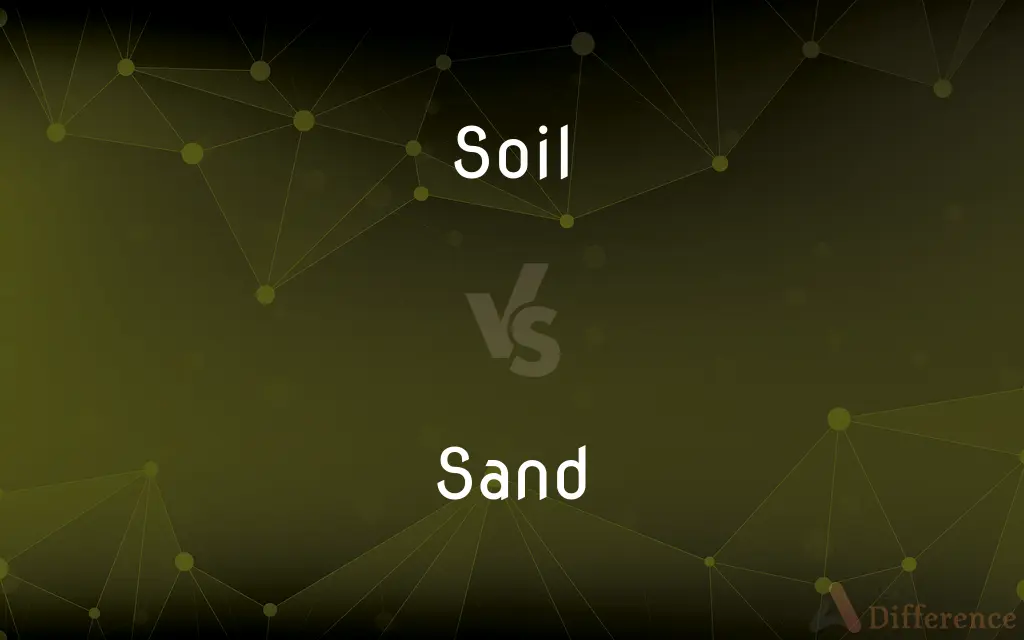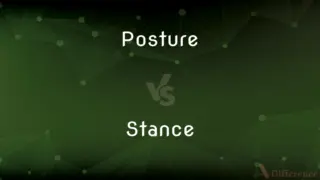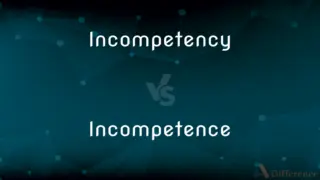Soil vs. Sand — What's the Difference?
By Tayyaba Rehman — Updated on October 12, 2023
Soil is the upper layer of earth where plants grow, a mixture of organic remains, minerals, and water; Sand is a naturally occurring granular substance composed mainly of tiny particles of rock or minerals.

Difference Between Soil and Sand
Table of Contents
ADVERTISEMENT
Key Differences
Soil, as a term, encompasses the topmost layer of the Earth's crust, vital for terrestrial plant life. It is rich, varied, and consists of decomposed organic material, clay, silt, minerals, and a host of living organisms. Sand, on the other hand, holds a more specific definition. It's a granular substance predominantly made up of finely divided rock and mineral particles. The earth has different types of soil, each with its unique composition and properties, which can support a wide variety of flora and fauna. Sand is often found in deserts, along coasts, and in certain types of soil mixtures, usually unable to support diverse plant life due to its drainage properties and lack of nutrients.
While soil is often teeming with life, playing host to countless microorganisms, fungi, and insects, sand typically lacks this biological diversity. This is primarily due to sand's rapid drainage, making it difficult for it to retain the moisture and nutrients necessary to support a wide range of life. Soil's ability to retain water and nutrients is crucial for plants, providing them with the sustenance they need to grow and thrive. Sand, while a component in some soil types, doesn't have this capacity on its own.
In cultural and idiomatic contexts, soil and sand can represent more than just earthly materials. Soil may symbolize one's home or origin, as in "soil of one's birth." Sand might be used to signify time, as in the phrase "sands of time," or impermanence given its shifting nature. Both are integral to our planet's geology, but they serve different roles in the ecosystem, agriculture, construction, and even symbolism.
Lastly, when it comes to their role in human activities, soil is primary for agriculture, supporting crops and vegetation. Rich, fertile soil is a coveted resource for farmers. Sand, due to its texture and consistency, is vital for construction, especially in making concrete, and is also used in manufacturing and filtration processes.
Comparison Chart
Primary Composition
Mixture of organic remains, minerals, water, and organisms
Tiny particles of rock or minerals
ADVERTISEMENT
Supports Plant Life
Yes, offers nutrients and water retention
Generally, no; lacks nutrients and retains little water
Location
Found universally, varies in composition based on location
Deserts, beaches, and as a component in some soils
Symbolism
Can represent home, origin, fertility
Might symbolize time, impermanence
Human Use
Agriculture, plant growth
Construction, manufacturing, filtration
Compare with Definitions
Soil
The top layer of earth in which plants grow.
Plants get their nutrients from the soil.
Sand
A substance made of fine particles of rock and mineral.
The beach was covered in golden sand.
Soil
A particular kind of earth or ground.
Clayey soil is great for pottery.
Sand
To smooth or polish with sandpaper.
He sanded the wooden table before painting.
Soil
Soil is a mixture of organic matter, minerals, gases, liquids, and organisms that together support life. Earth's body of soil, called the pedosphere, has four important functions: as a medium for plant growth as a means of water storage, supply and purification as a modifier of Earth's atmosphere as a habitat for organismsAll of these functions, in their turn, modify the soil and its properties.
Sand
A beach or desert.
The kids love playing in the sand.
Soil
The top layer of the earth's surface in which plants can grow, consisting of rock and mineral particles mixed with decayed organic matter and having the capability of retaining water.
Sand
Sand is a granular material composed of finely divided rock and mineral particles. Sand has various compositions but is defined by its grain size.
Soil
A particular kind of earth or ground
Sandy soil.
Sand
Small loose grains of worn or disintegrated rock.
Soil
Country; land
Native soil.
Sand
(Geology) A sedimentary material, finer than a granule and coarser than silt, with grains between 0.06 and 2.0 millimeters in diameter.
Soil
The agricultural life
A man of the soil.
Sand
Often sands A tract of land covered with sand, as a beach or desert.
Soil
A place or condition favorable to growth; a breeding ground.
Sand
The loose, granular, gritty particles in an hourglass.
Soil
The state of being soiled.
Sand
Sands Moments of allotted time or duration
"The sands are numb'red that makes up my life" (Shakespeare).
Soil
A stain.
Sand
(Slang) Courage; stamina; perseverance
"She had more sand in her than any girl I ever see.
In my opinion she was just full of sand" (Mark Twain).
Soil
Filth, sewage, or refuse.
Sand
A light grayish brown to yellowish gray.
Soil
Manure, especially human excrement, used as fertilizer.
Sand
To sprinkle or cover with or as if with sand.
Soil
To make dirty, particularly on the surface.
Sand
To polish or scrape with sand or sandpaper.
Soil
To disgrace; tarnish
A reputation soiled by scandal.
Sand
To mix with sand.
Soil
To corrupt; defile.
Sand
To fill up (a harbor) with sand.
Soil
To dirty with excrement.
Sand
(uncountable) Rock that is ground more finely than gravel, but is not as fine as silt (more formally, see grain sizes chart), forming beaches and deserts and also used in construction.
Soil
To become dirty, stained, or tarnished.
Sand
A beach or other expanse of sand.
The Canadian tar sands are a promising source of oil.
Soil
To feed (livestock) with soilage.
Sand
Personal courage.
Soil
(uncountable) A mixture of mineral particles and organic material, used to support plant growth.
Sand
A particle from 62.5 microns to 2 mm in diameter, following the Wentworth scale.
Soil
(uncountable) The unconsolidated mineral or organic material on the immediate surface of the earth that serves as a natural medium for the growth of land plants.
Sand
A light beige colour, like that of typical sand.
Soil
(uncountable) The unconsolidated mineral or organic matter on the surface of the earth that has been subjected to and shows effects of genetic and environmental factors of: climate (including water and temperature effects), and macro- and microorganisms, conditioned by relief, acting on parent material over a period of time. A product-soil differs from the material from which it is derived in many physical, chemical, biological, and morphological properties and characteristics.
Sand
A single grain of sand.
Soil
Country or territory.
Sand
A moment or interval of time; the term or extent of one's life (referring to the sand in an hourglass).
Soil
That which soils or pollutes; a stain.
Sand
(colloquial) A sandpiper.
Soil
A marshy or miry place to which a hunted boar resorts for refuge; hence, a wet place, stream, or tract of water, sought for by other game, as deer.
Sand
Of a light beige colour, like that of typical sand.
Soil
Dung; compost; manure.
Sand
(transitive) To abrade the surface of (something) with sand or sandpaper in order to smooth or clean it.
Soil
Faeces or urine etc. when found on clothes.
Sand
(transitive) To cover with sand.
Soil
A bag containing soiled items.
Sand
To blot ink using sand.
Soil
A wet or marshy place in which a boar or other such game seeks refuge when hunted.
Sand
Fine particles of stone, esp. of siliceous stone, but not reduced to dust; comminuted stone in the form of loose grains, which are not coherent when wet.
That finer matter, called sand, is no other than very small pebbles.
Soil
(transitive) To make dirty.
Sand
A single particle of such stone.
Soil
(intransitive) To become dirty or soiled.
Sand
The sand in the hourglass; hence, a moment or interval of time; the term or extent of one's life.
The sands are numbered that make up my life.
Soil
To stain or mar, as with infamy or disgrace; to tarnish; to sully.
Sand
Tracts of land consisting of sand, like the deserts of Arabia and Africa; also, extensive tracts of sand exposed by the ebb of the tide.
Soil
(reflexive) To dirty one's clothing by accidentally defecating while clothed.
Sand
Courage; pluck; grit.
Soil
To make invalid, to ruin.
Sand
To sprinkle or cover with sand.
Soil
To enrich with soil or muck; to manure.
Sand
To drive upon the sand.
Soil
To feed, as cattle or horses, in the barn or an enclosure, with fresh grass or green food cut for them, instead of sending them out to pasture; hence (due to such food having the effect of purging them) to purge by feeding on green food.
Sand
To bury (oysters) beneath drifting sand or mud.
Soil
To feed, as cattle or horses, in the barn or an inclosure, with fresh grass or green food cut for them, instead of sending them out to pasture; hence (such food having the effect of purging them), to purge by feeding on green food; as, to soil a horse.
Sand
To mix with sand for purposes of fraud; as, to sand sugar.
Soil
To enrich with soil or muck; to manure.
Men . . . soil their ground, not that they love the dirt, but that they expect a crop.
Sand
A loose material consisting of grains of rock or coral
Soil
To make dirty or unclean on the surface; to foul; to dirty; to defile; as, to soil a garment with dust.
Our wonted ornaments now soiled and stained.
Sand
French writer known for works concerning women's rights and independence (1804-1876)
Soil
To stain or mar, as with infamy or disgrace; to tarnish; to sully.
Sand
Fortitude and determination;
He didn't have the guts to try it
Soil
To become soiled; as, light colors soil sooner than dark ones.
Sand
Rub with sandpaper;
Sandpaper the wooden surface
Soil
The upper stratum of the earth; the mold, or that compound substance which furnishes nutriment to plants, or which is particularly adapted to support and nourish them.
Sand
Courage; stamina; grit.
It takes sand to face challenges head-on.
Soil
Land; country.
Must I thus leave thee, Paradise? thus leaveThee, native soil?
Soil
Dung; fæces; compost; manure; as, night soil.
Improve land by dung and other sort of soils.
Soil
A marshy or miry place to which a hunted boar resorts for refuge; hence, a wet place, stream, or tract of water, sought for by other game, as deer.
As deer, being stuck, fly through many soils,Yet still the shaft sticks fast.
O, sir, have you taken soil here? It is well a man may reach you after three hours' running.
Soil
That which soils or pollutes; a soiled place; spot; stain.
A lady's honor . . . will not bear a soil.
Soil
The state of being covered with unclean things
Soil
The part of the earth's surface consisting of humus and disintegrated rock
Soil
Material in the top layer of the surface of the earth in which plants can grow (especially with reference to its quality or use);
The land had never been plowed
Good agricultural soil
Soil
The geographical area under the jurisdiction of a sovereign state;
American troops were stationed on Japanese soil
Soil
Make soiled, filthy, or dirty;
Don't soil your clothes when you play outside!
Soil
To dirty or stain something.
He soiled his shirt while playing.
Soil
The material on the surface of the ground in which plants grow.
The forest floor was covered in rich, dark soil.
Soil
Country; territory; a particular land.
This is the soil of my ancestors.
Common Curiosities
Why can't most plants grow in just sand?
Sand lacks the nutrients and water retention capacity most plants need.
Can sand be a component of soil?
Yes, sandy soil is a type that has a high proportion of sand.
Can sand hold water?
Sand drains quickly, so it retains very little water.
Is soil alive?
Yes, soil is teeming with microorganisms, insects, and organic matter.
Is all sand the same?
No, sand can vary in color, grain size, and mineral composition depending on its origin.
Is soil always dark in color?
No, soil color varies based on its composition, ranging from reds to browns to grays.
How is sand formed?
Sand forms from the weathering and erosion of rocks over time.
Why is soil health important for agriculture?
Healthy soil provides nutrients, water retention, and support for crops.
Are deserts made up entirely of sand?
No, while many deserts have sand dunes, they also have rocky and gravelly areas.
Can plants grow in pure sand?
While most plants struggle in pure sand due to lack of nutrients, some plants, like cacti or beach grasses, have adapted to such conditions.
What's the difference between sandy soil and loamy soil?
Sandy soil has more sand, while loamy soil has a balanced mix of sand, silt, and clay.
How can soil be rejuvenated or made more fertile?
Soil fertility can be enhanced through composting, crop rotation, and adding organic matter or fertilizers.
Is potting soil the same as garden soil?
No, potting soil is specially formulated for container plants and usually has a mix of peat, compost, and other materials to ensure good drainage.
Why are some soils red or yellow?
The color often comes from iron oxides present in the soil, giving it a reddish or yellowish hue.
How do dunes form in deserts and coastal areas?
Dunes form from windblown sand that accumulates around obstacles or is shaped by varying wind directions.
Is quicksand a type of sand?
Quicksand is a mixture of sand, water, clay, and organic material, giving it a liquid-like feel. It's not a distinct type of sand but rather a condition of saturation.
What's the difference between topsoil and subsoil?
Topsoil is the uppermost layer, rich in organic material and nutrients. Subsoil is beneath topsoil and has fewer organic materials but might have more minerals.
Can sand be used to improve soil drainage?
Yes, adding sand to clayey soils can improve drainage, but the amount and type of sand, as well as the existing soil composition, should be considered.
Why do some plants prefer acidic soil?
Some plants have evolved in acidic environments and have adapted to extract nutrients best from such soils.
Share Your Discovery

Previous Comparison
Posture vs. Stance
Next Comparison
Incompetency vs. IncompetenceAuthor Spotlight
Written by
Tayyaba RehmanTayyaba Rehman is a distinguished writer, currently serving as a primary contributor to askdifference.com. As a researcher in semantics and etymology, Tayyaba's passion for the complexity of languages and their distinctions has found a perfect home on the platform. Tayyaba delves into the intricacies of language, distinguishing between commonly confused words and phrases, thereby providing clarity for readers worldwide.














































